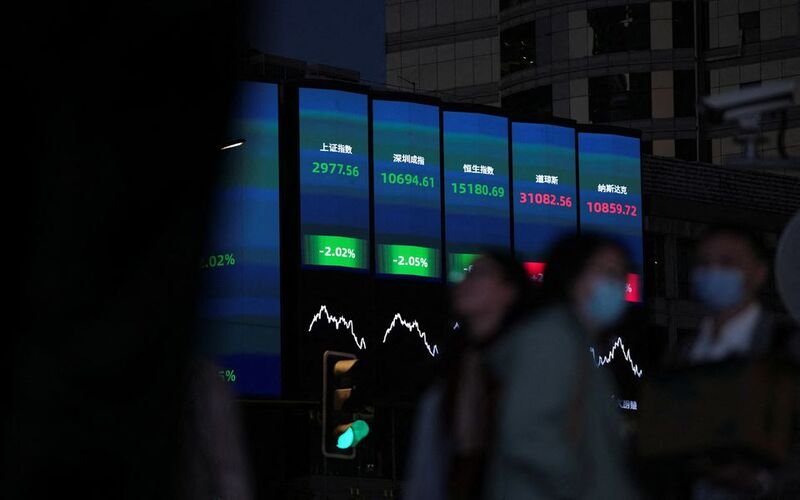The dollar fell on Tuesday as traders avoided making wagers in advance of economic data that is anticipated to give hints as to the next measures that would be taken by the United States Federal Reserve.
At the same time, Asian shares climbed modestly to stand just off their lowest since November 2022. The markets were concerned that the fight between Israel and Hamas may develop into a larger conflict in the region where oil is exported, so oil prices recovered some of the ground they had lost the previous day.
The MSCI, the broadest index of Asia-Pacific shares outside of Japan (.MIAPJ0000PUS), reversed losses to trade 0.41% higher at 476.72, from an earlier bottom of 472.73, the lowest level since November 2022. The index is already 3% down for the month, putting it on track for a loss for the third month. Following an earlier drop of as much as 1.4%, Japan’s Nikkei (.N225) was seen to have gained 0.21%.
The futures market indicated that European stock markets were about to begin in the red. The Eurostoxx 50 futures were trading down 0.10%, the German DAX futures were trading down 0.11%, and the FTSE futures were trading down 0.16%. “The looming specter of inflation grows even more imposing, especially considering the recent sharp ascent in oil prices,” said Gary Dugan, Chief Investment Officer at Dalma Capital.
“If oil prices persist at this level throughout the rest of 2023 and into 2024, this could potentially inject another bout of inflation into the global economy.”
The quarterly reports of high-profile businesses, including Microsoft (MSFT.O), Facebook parent Meta Platforms (META.O), and Amazon (AMZN.O), will compete for the attention of investors this week. Additionally, a torrent of economic data will be released this week before the Federal Reserve’s meeting from October 31 to November 1.
On Thursday, the United States Department of Commerce will reveal the gross domestic product for the third quarter. On Friday, the United States Central Bank will release its preferred inflation barometer, the Personal Consumption Expenditures (PCE) report.
However, before that, investors will analyze the flash purchasing managers’ index (PMI) data from Britain, France, the Eurozone, and the United States, which are expected to be released on Tuesday.
The onslaught of data comes just before central bank meetings in the next two weeks, the first of which is scheduled for Thursday and will be held by the European Central Bank, according to the results of a poll conducted by Reuters with 85 market analysts.
“It’s already reasonable to suggest that the ECB won’t move on rates this week,” said Michael Hewson, chief market analyst at CMC Markets in London. “The October flash PMIs merely served to underscore how weak the European economy remains,” he said. “It’s already reasonable to suggest that the ECB won’t move on rates this week.”
Although the Shanghai Composite Index (.SSEC) saw a gain of 0.32%, the Hang Seng Index (.HSI) in Hong Kong continued its downward trend, down 0.68 percent. Despite this, the pressure on China’s shares continued. The blue-chip CSI300 Index (.CSI300) in China was unchanged on Tuesday after closing at its lowest level in four and a half years on Monday.
Even when the state fund Central Huijin acquired exchange-traded funds to support the sagging market, investor confidence remained low for an extended period.
In Asian trading hours on Tuesday, the yield on the benchmark 10-year U.S. Treasury note rose 0.80 basis points to 4.846%. This comes after the yield on the same note dropped precipitously the previous day after briefly rising above 5%. The rise in rates on 10-year Treasury notes used as a standard for determining the costs of borrowing worldwide and considered a haven in times of economic instability has been partly driven by investors’ pricing in greater growth in the United States.
Bill Ackman, a billionaire investor, stated on Monday that he had covered his past wagers against Treasury bonds because he anticipated that the conflict between Israel and Hamas would drive more investor dollars into U.S. Treasury bonds.
After suffering a loss of 0.5% on Monday, the dollar’s value decreased compared to a group of currencies traded on the market. At 105.52, the dollar index was 0.076% weaker than its previous value. The yen continued under pressure, although the dollar’s retreat supported the currency.
The Japanese yen’s exchange rate with the U.S. dollar was last seen at 149.74 per dollar, having reached the crucial level of 150 on Friday and Monday. According to market sentiment, reaching this level can prompt an intervention by the government to support the currency.
In the realm of cryptocurrencies, bitcoin had a resurgence in popularity due to speculation around the prospect of an exchange-traded fund, driving enthusiasm and prompting short-sellers to liquidate positions.
After reaching an 18-month high of $35,198 during trading, the most popular cryptocurrency in the world eventually settled at $34,427, representing a daily gain of 4%.
The price of a barrel of West Texas Intermediate oil in the United States increased by 0.32%, reaching $85.76, while the price of a barrel of Brent increased by 0.33%, reaching $90.13. The price of an ounce of spot gold increased by 0.2%, reaching $1,975.49.











































Comment Template